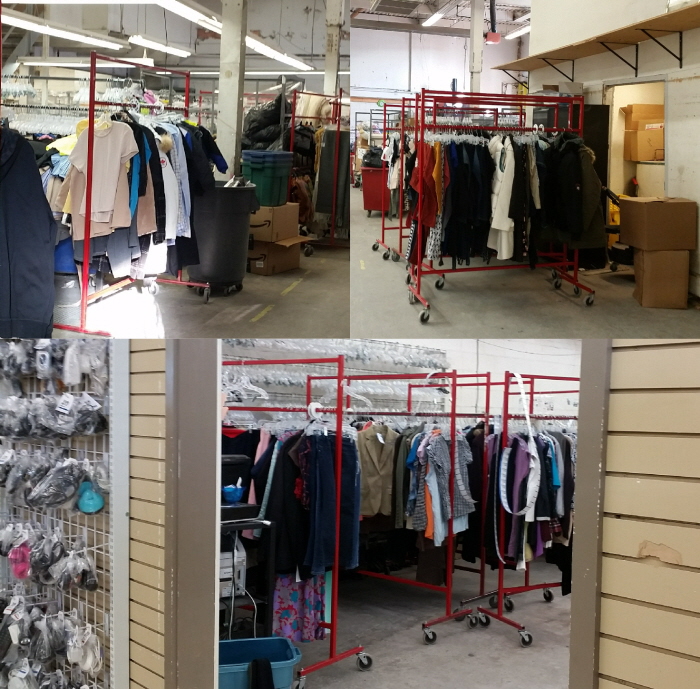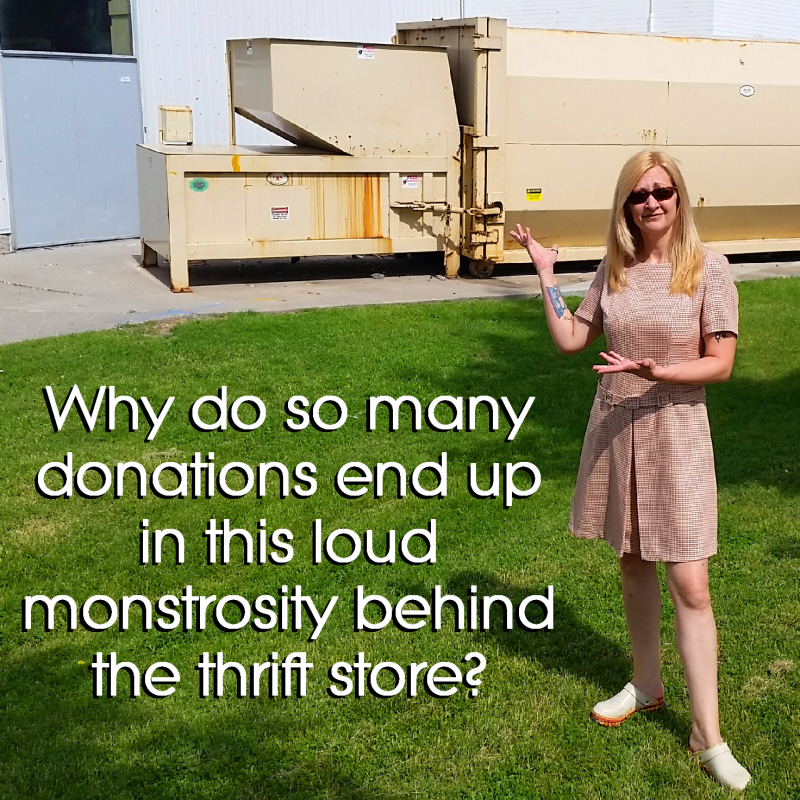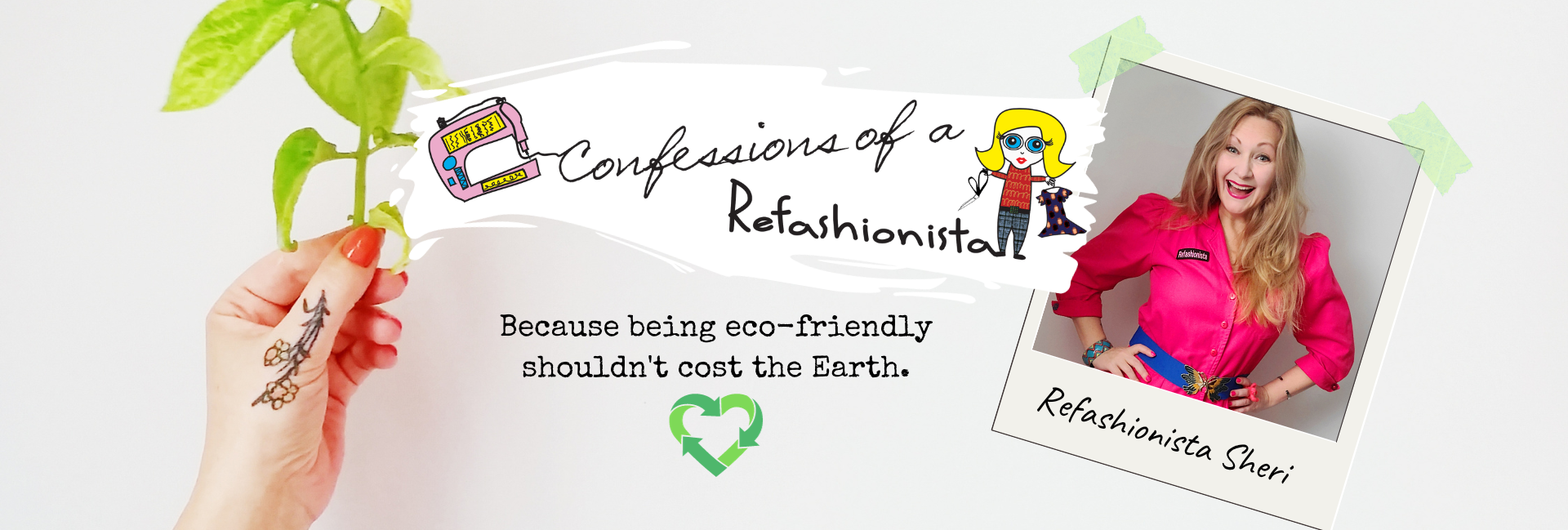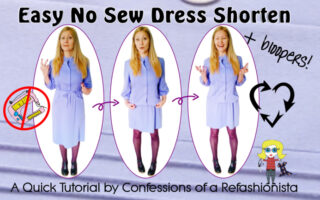My gone thrifting group is full of awesome preloved style divas who have helped me create a community where we spread the sustainable lifestyle love as well as share projects, ideas, thrifty style and upcycling inspiration. During a recent thrifty query Q&A one of my fellow thrifty gurus mentioned that she had worked at a well-known for profit thrift shop and generously agreed to be interviewed about her experiences by this refashionista!

Grab a cuppa and take a look behind the scenes at a for profit thrift shop with me:

Why did you decide to work behind the scenes at a for profit thrift shop?
I had recently graduated from a graphic design college and had been unsuccessful in finding a job. I saw the ad on a job site and, as a lifelong thrifter, I thought it would be interesting to work there. I was hired the same day I interviewed.
What was your job?
I was a pricer/production assistant. I became lead pricer on the kidswear line but I also did sorting, hanging, tagging and pricing in other areas as well.
Did you receive a fair wage and benefits for the work that was expected of you?
It seemed fair, at first. Eventually, there was incredible pressure to increase the amount of items priced daily so it became more tiring but there wasn’t compensation for the extra work. Also, there was a high disregard (from management) for our personal safety. We were not permitted to wear gloves while sorting (too expensive), there were a number of people who immediately were given written warnings for perceived infractions and the permanent 50% discount after ten years of service was removed.
What were the positives about working there?
I loved the great people I met, some of whom are still friends, I loved the fun atmosphere and sorting through treasures. I not only enjoyed finding some treasures for myself but I loved the idea that what I was doing might help someone on a tight budget or help to avoid further damage to our environment.
What were the negatives about working there?
The impossible quotas we were given, the pressure to be competitive with first-run retail stores and the shift in marketing from saving the environment and offering great deals to catering to a younger hip crowd contributed to my disillusionment with that chain.
There was more of an emphasis on getting product on the floor, regardless of condition, and pricing higher. I was told that if I thought an item was worth $1.99 to bump it up by a dollar or more. When I questioned the ethics of that I was reprimanded and put on probation. I quit shortly after.
Thrift store prices are incredibly confusing – was there a system you had to follow?
Yes, and it was confusing to me too! Some of the system made sense like tags ending in certain numbers and organizational codes. Other methods just seemed ridiculous such as bumping up prices or pricing brand name items as high or higher than new. A lot of it just seemed to be “price as high as you can, get it out on the floor and don’t answer any questions from customers!”

Are there any insights you can offer as to why the prices are so over the top?
I believe it has a lot to do with the change in demographics, how thrift shops are trying to market themselves as hip alternative stores rather than fulfilling a need or helping people on a budget. When I started thrifting in my teens it was not cool to admit your clothes were secondhand! When I worked at this particular store I was told I was never to use the words “thrift” or “used” or “secondhand” on the sales floor as the corporation wanted customers to associate the store with a different image.

Do you know what happens to the tons of donations that don’t make it onto the shop floor?
Unfortunately not as much of donated clothing gets resold as people may think. A portion is baled as rags, only about a third of what we sorted was deemed suitable for selling but a considerable amount would just simply be trashed. It isn’t just the thrift stores that are at fault with waste. Often, on Monday mornings especially, we would arrive at work and find garbage bags, trashed and broken furniture, broken dishes, stuff like that, sitting behind our receiving doors. We’d have to clean it up so that people could drive in with their donations.

As consumers, can we really believe anything that we’re told by the clever thrift shop marketing teams?
I still believe some of the non-profit stores are ethical and honest. But I don’t believe anything that for-profit stores say anymore! Having a marketing background and working in a thrift store helps one understand the strategies they’re using to mislead people! I still shop there on occasion but I do so with a practised and cynical eye!
What were some of the more memorable donations you sorted (& did they make it onto the floor)?
I was forced to put things on the floor before I could purchase them! Store policy was that an item had to be on the floor for five minutes and we could only shop during lunch break or after our shift. But there’s always ways around that, if you’re on good terms with the pricer…
Your most interesting find?
I found some great treasures like a Louis Vuitton bag that no one knew how to verify (but I did!) and some great vintage pieces but the most interesting find was a framed caricature I had drawn of a couple a few years before and then it ended up being donated! I guess they didn’t like my perception of them! I wasn’t permitted to take it but my co-worker priced it extremely low and then hid it, so I bought it after I finished work.
Any strange but true stories?
I was stunned by how disgusting people are when I began working there! Often, we’d open a bag to find used diapers, garbage, moldy food, clothes and furniture with who-knows-what stained on them and even a dead mouse! The worst for me was the time I cut open a bag and a huge wolf spider crawled out. I am arachnophobic and my screams were heard out on the sales floor! My manager was quite peeved at me but my co-workers were very concerned.

Anything else you’d like to share?
I still love thrifting and probably 80-90% of my wardrobe and furnishings are thrifted, DIY’ed or gifts. I believe that we owe it to our budget, our environment and the rest of the world to be responsible and ethical with our spending habits and resources. North America has been blessed with abundance and I think it’s selfish and vain to overspend and throw things away without regard to what it does to other people or our environment.
I dislike the thought that what I buy (because of the social pressures to be “on trend”) forces someone else to work in horrendous conditions and allows huge corporations to rake in obscene amounts of money. Thrifting is also a creative challenge for me. I love seeing the potential in a garment and I love seeing friends find a great treasure!

Huge thanks and a massive bear squeeze to this awesome thrifty diva (& amazing caricature artist!) for sharing her experience with us!
Share your thoughts below then head on over and take part in an upcoming thrifty query with the Gone Thrifting group!
If you’d like to refashion your entire wardrobe for pennies yourself check out my E-courses right over here:
and start your sustainable lifestyle journey with my groovy CoaR tutorial E-book collections right here:









Thanks for this interview, I appreciate the honesty. I volunteer for a thrift store that is part of the local senior center. All volunteer staffed and all of our profits go straight back to the senior center to lower the cost of the classes and programs offered . We recycle textiles, electronics, metal, glass, paper and plastic bags. We donate clothing to a local nursing home and fill a clothing rack at a soup kitchen. We offer our books for free because we believe everyone should have access to reading materials of all kinds. There are lots of ways to support your community and I feel like these corporations are doing us a disservice with their high pricing and throw away mentality. Keep it local!
I’m constantly shocked at the high prices and total lack of quality control in the for-profit thrift shops and large chain charity shops in Canada. The staff seem to do the best they can with the tools they are given and have absolutely zero control over the prices but thrifting would be a lot more pleasant if damaged/destroyed/filthy items were removed from the racks are not put out for sale at all 🙁